“Wright’s new control” was the heading of a 1914 report in the “New York Times.” It stated that Orville Wright had introduced a new system that would make it “easier and safer to fly.” In the new controls the usual lever was replaced by an automobile-type steering wheel in combination with a lever that made the control stronger and simpler.
Even though three-axis control has been with us since the Wright brothers, the methods of actuating the control surfaces took a long time to standardize to the current system.
In December 1913, the magazine, “The Aero,” from Great Britain had a two-part article on control systems as seen on aircraft at the Paris Airplane Show of that year. Of the seven systems discussed, five used control wheels and two used control sticks — none of which was close to what are used today.
The article began: “If there be one part of an aeroplane which of all others each designer makes a thoroughly distinctive and individual manner, it is the arrangement of the controls. This state of affairs is, of course, exactly the reverse of what it should be, for controls should be standardized.”
Control gears may practically be divided into three characteristic sections — those which are simple and instinctive; those which are clever, and those which are both. In order to avoid any invidious comment I will leave readers to settle in their own minds which are which.”
ANTOINETTE
“This is the control gear of the Antoinette (Figure 1), which is, in the writer’s estimation one of the two blots on an otherwise nearly perfect machine,” the article continued. “Its fault lies in the fact that the warping of the wings is affected by a hand wheel whose axis lies across the machine instead of along it.
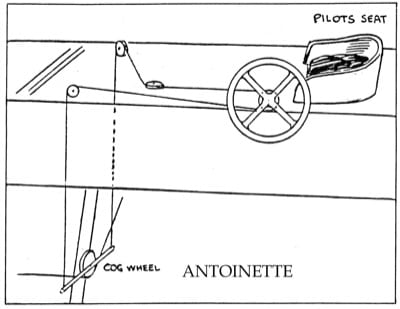
“One rotates the wheel forward to turn to one side and backwards to turn to the other, and as there is no reason at all why these arbitrary causes and effects should be interchanged, a certain effort of memory must be required to recollect exactly what does what until long hours of practice have turned into second nature a thoroughly unnatural habit.”
FARMAN
In the Henry Farman system (Figure 2), a universally-joined lever is used in which a side-to-side movement is used for lateral control and forward and aft for longitudinal control. The rudder was controlled by a foot-operated lever.
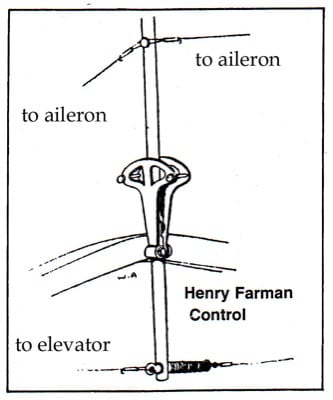
R.E.P.
The R. E. P. (Robert Esnault-Pelterie) control (Figure 3) has some of the basic features of the modern joy stick. The elevator was controlled by a fore and aft movement on the stick and the wing warping by a side-to-side motion. Unusual for its time, the controls were connected to the control level by means of tube instead of wires.
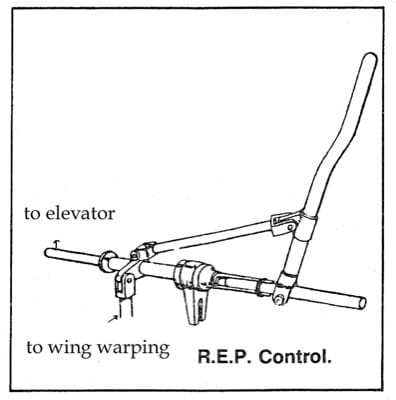
BREGUET
The Breguet control (Figure 4) is an all-in-one control that puts all three axis in a single hand control. The control column is joined to the fuselage near the lower end with a universal joint. At the top end is a hand wheel through which the rudder and front skid are controlled via a chain and sprocket gear. The rudder is actuated by rotating the wheel around its axis. A side-to-side movement of the column controlled the wing warping and the elevator by movement fore and aft.
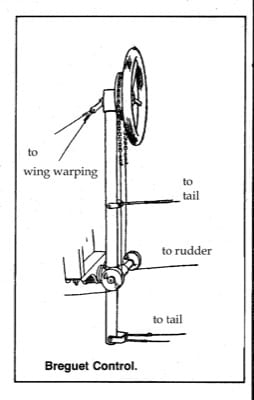
At the time of the article, 1913, it was open to question which control — the rudder or the ailerons — was the most important for turning the machine. This brought about some confusion as to which controls should be primary to the pilot’s natural sense of turning.
The author agreed that: “Whichever it be, that organ (i.e., control) ought to be controlled by an action which involves the instinctive movement of the aviator towards the side on which the turn is to take place.”
DEPERDUSSIN
Now we come to the basis of the modern, standard, control system known in the early days as the Dep. (short for Deperdussin) Control. In this system (Figure 5) a structure resembling an inverted U carries a hand wheel, the forward and backward movement of which operates the elevator, while rotation of the wheel actuates the wing warp (later aileron), while a traverse foot bar controls the rudder.
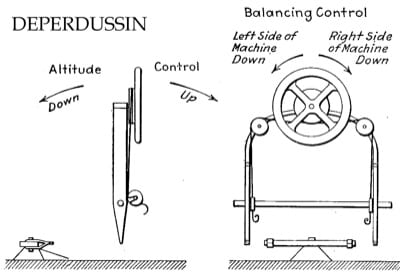
The first Deperdussin, built in 1910, featured this control system. This system, which used a stick instead of a wheel, became common to aircraft during the First World War. During the 1930s control wheels became the standard for cabin aircraft. Today, levers have returned again with side sticks seen on Airbus commercial jets and Cirrus light aircraft.
More than 100 years after the Wrights figured out three-axis control, airplane designers are still trying to figure out the best way to control an airplane.
Dennis Parks is Curator Emeritus of Seattle’s Museum of Flight. He can be reached at [email protected].
